Yeohelmetguy
Well-known member
Hello all.
Those frequent Forum members who more routinely read/view/comment on my various posts are well aware that my interests revolve around Victorian and Edwardian British Army headdress, primarily dragoon helmets and home service helmets and associated accoutrements, their associated helmet plates. There is one small subset to my helmet plate collection, that in general is overlooked with very little notice or recognition paid, the grenade badges to the nine British Army regular regiments of fusiliers. The nine fusilier regiments were formed in 1881 as a result of the Cardwell reforms by either amalgamating two one battalion regiments or redesignating two battalions in the same regiment as fusiliers, regimental numbers were done away with replaced by county names. These nine regiments unlike the other regular infantry regiments of the line replaced the 1878 blue cloth covered cork home service helmet with a racoon skin busby, bear skin for officers, each of the nine regiments being distinguished by the combination of grenade badges affixed to the front of the busby and the color of the plume worn on either the right or left side of the busby. In order of precedents their plume color and placement are: the Northumberland Fusiliers red over white plume worn on the left, formerly the 5th Foot; the Royal Fusiliers (City of London) Regiment red over white worn on the right, formerly the 7th Foot; The Lancashire Fusiliers, yellow worn on the left, formerly the 20th Foot; the Royal Scots Fusiliers, white worn on the right, formerly the 21st Foot; the Royal Welsh Fusiliers, white worn on the right, formerly the 23rd Foot; the Inniskilling Fusiliers, white worn on the left formerly the 27th and 108th Regiments of Foot; the Princess Victoria's (Royal Irish) Fusiliers, green worn on the left, formerly the 87th and 89th Regiments of Foot; the Royal Munster Fusiliers, white over green worn on the left, formerly the 101st and 104th Regiments; the Royal Dublin Fusiliers, green worn on the left, formerly the 102nd and 103rd Regiments. Of the nine regiments, one was Scottish, one Welsh, three English, and four were Irish. The four Irish regiments were disbanded in 1922 with the creation of the Irish Free State. The remaining five regiments were, over the years, amalgamated and/or disbanded to ultimately be represented in the present-day Royal Regiment of Fusiliers.
Cheers,
David
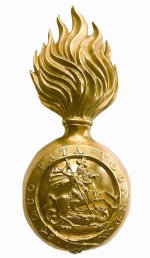
THE NORTHUMBERLAND FUSILIERS OFFICER'S GRENADE
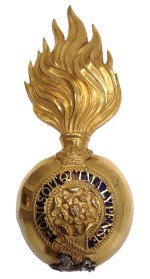
THE ROYAL FUSSILIERS (CITY OF LONDON) REGIMENT OFFICER'S GRENADE
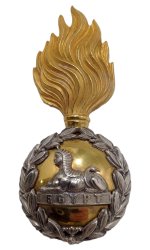
THE LANCASHIRE FUSILIERS OFFICER'S GRENADE
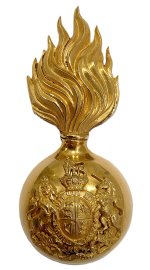
ROYAL SCOTS FUSILIERS OFFICER'S GRENADE

ROYAL WELSH FUSILIERS OFFICER'S GRENADE
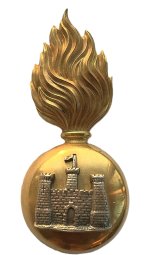
INNISKILLING FUSILIERS OFFICER'S GRENADE
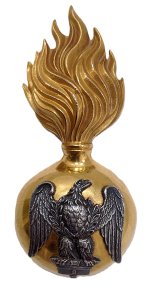
PRINCESS VICTORIA'S (ROYAL IRISH) FUSILIERS
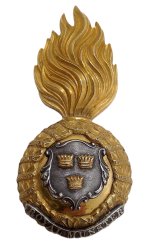
THE ROYAL MUNSTER FUSILIERS OFFICER'S GRENADE
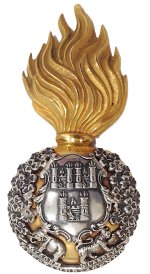
ROYAL DUBLIN FUSILIERS OFFICER'S GRENADE
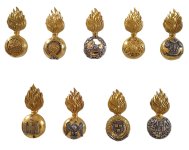
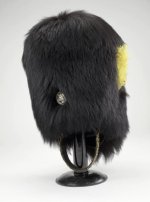
OFFICER'S BUSBY, THE LANCASHIRE FUSILIERS
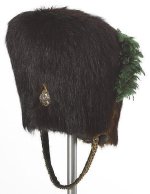
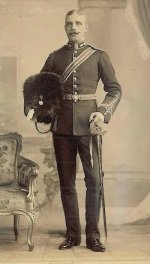
OFFICER'S BUSBY, PRINCESS VICTORIA'S (ROYAL IRISH) FUSILIERS
Those frequent Forum members who more routinely read/view/comment on my various posts are well aware that my interests revolve around Victorian and Edwardian British Army headdress, primarily dragoon helmets and home service helmets and associated accoutrements, their associated helmet plates. There is one small subset to my helmet plate collection, that in general is overlooked with very little notice or recognition paid, the grenade badges to the nine British Army regular regiments of fusiliers. The nine fusilier regiments were formed in 1881 as a result of the Cardwell reforms by either amalgamating two one battalion regiments or redesignating two battalions in the same regiment as fusiliers, regimental numbers were done away with replaced by county names. These nine regiments unlike the other regular infantry regiments of the line replaced the 1878 blue cloth covered cork home service helmet with a racoon skin busby, bear skin for officers, each of the nine regiments being distinguished by the combination of grenade badges affixed to the front of the busby and the color of the plume worn on either the right or left side of the busby. In order of precedents their plume color and placement are: the Northumberland Fusiliers red over white plume worn on the left, formerly the 5th Foot; the Royal Fusiliers (City of London) Regiment red over white worn on the right, formerly the 7th Foot; The Lancashire Fusiliers, yellow worn on the left, formerly the 20th Foot; the Royal Scots Fusiliers, white worn on the right, formerly the 21st Foot; the Royal Welsh Fusiliers, white worn on the right, formerly the 23rd Foot; the Inniskilling Fusiliers, white worn on the left formerly the 27th and 108th Regiments of Foot; the Princess Victoria's (Royal Irish) Fusiliers, green worn on the left, formerly the 87th and 89th Regiments of Foot; the Royal Munster Fusiliers, white over green worn on the left, formerly the 101st and 104th Regiments; the Royal Dublin Fusiliers, green worn on the left, formerly the 102nd and 103rd Regiments. Of the nine regiments, one was Scottish, one Welsh, three English, and four were Irish. The four Irish regiments were disbanded in 1922 with the creation of the Irish Free State. The remaining five regiments were, over the years, amalgamated and/or disbanded to ultimately be represented in the present-day Royal Regiment of Fusiliers.
Cheers,
David

THE NORTHUMBERLAND FUSILIERS OFFICER'S GRENADE

THE ROYAL FUSSILIERS (CITY OF LONDON) REGIMENT OFFICER'S GRENADE

THE LANCASHIRE FUSILIERS OFFICER'S GRENADE

ROYAL SCOTS FUSILIERS OFFICER'S GRENADE

ROYAL WELSH FUSILIERS OFFICER'S GRENADE

INNISKILLING FUSILIERS OFFICER'S GRENADE

PRINCESS VICTORIA'S (ROYAL IRISH) FUSILIERS

THE ROYAL MUNSTER FUSILIERS OFFICER'S GRENADE

ROYAL DUBLIN FUSILIERS OFFICER'S GRENADE


OFFICER'S BUSBY, THE LANCASHIRE FUSILIERS


OFFICER'S BUSBY, PRINCESS VICTORIA'S (ROYAL IRISH) FUSILIERS
Last edited:
